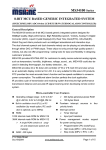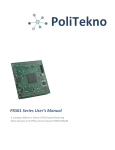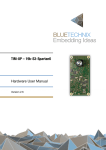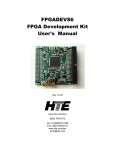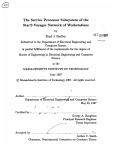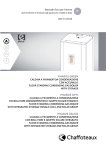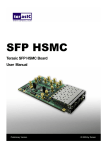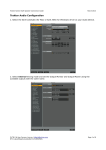Download Logi-Pi User Guide
Transcript
Logi-Pi User Guide From ValentFx Wiki LOGi Pi - Bringing FPGA Technology to the Raspberry Pi Contents 1 Overview 1.1 Features 1.2 Peripherals 2 Electrical 3 Interfacing 3.1 Top Level Block Diagram 3.2 RA2.1 Raspberry Pi Connector Interface 3.3 PMOD Expansion Port 3.4 Arduino Expansion Port 3.5 LVDS Expansion Port 3.6 LVDS signal usage 3.7 Push Button Usage 3.8 DIP Switch Usage 3.9 LED Usage 3.10 JTAG Interface 4 Programming the FPGA from the Raspberry Pi 5 Raspberry Pi SPI to FPGA Interface 5.1 Direct SPI Communication to FPGA 5.2 SPI to Wishbone Interface Bandwidth 6 Useful Links 6.1 LOGi - Repository - Projects, Libraries, Drivers 6.2 LOGi-Pi Schematics 6.3 LOGI-Pi User Guide -LOGi-Pi documentation 6.4 LOGi Projects wiki - LOGI and Users projects will be documented here Overview The LOGi-Pi is the first FPGA development platform that has been optimized for use with the Raspberry Pi. The LOGi-Pi adds FPGA flexibility and capability that allows the Raspberry Pi to be easily morphed into endless digital applications. The FPGA/CPU combination the LOGi-Pi creates an incredibly powerful and versatile digital canvas for users to create their imaginative digital designs. Features FPGA: Spartan 6 LX9 – TQFP144 Package - XC6SLX9-2TQG144C Plug and play interfacing the Raspberry Pi Arduino Shield expansion allowing for more than 200 existing plug in hardware modules PMOD compatible headers allowing for more than 50 existing low cost hardware modules 4 layer optimized design to support maximum performance of high bandwidth applications Length tuned GPMC, SDRAM and LVDS signals for high performance applications 50 Mhz MEMS oscillator Peripherals 2x Push buttons 2x DIP Switch 1x High bandwidth SATA connector expansion port 44 FPGA IO available through PMOD and Arduino headers 2x Digilent Inc. PMOD ports supporting 59+ plug and play hardware modules 1x Arduino Header supporting 200+ Arduino Shield modules Optional I2C, SPI access from the Beaglebone 10x length matched LVDS pairs routed as: 100 ohm differential, 50 ohm single-ended 256 Mb SDRAM Electrical External Vin Connector Voltage Max. Voltage Min. 6V 4V The LOGi-Pi can be powered through the Raspberry Pi connector or from the on-board external power connector. If powering the LOGi-Pi from the Raspberry Pi connector, it is recommended that a 1A external power supply be used to power the Raspberry Pi. Most FPGA applications will not require the use of a separate external power supply to power the LOGi-Pi, but it is up to to ensure that the FPGA applications will not overload the Raspberry Pi power rails which will cause brown-outs and or system failures. All current LOGi applications can be run while being powered only from the Raspberry Pi connector. The user should test newly designed applications to ensure the FPGA load falls within acceptable values. Information relevant to the Raspberry Pi system power requirements can be found the Raspberry Pi wiki. The LOGi-Pi uses LDO regulators to supply 3V3 and 1V2 to the onboard peripherals and the FPGA in order to reduce costs. The power distribution was designed to allow maximum dissipated heat to the internal and external power planes. If very high demand applications are designed testing should be done to ensure that the LDO regulators are not overheated due to the heavy loads. All current applications have been tested including the heavy load of the bitcoin mining applications and no over-heating issues have been found. Interfacing The LOGi-Pi was designed to allow for easy expansion to a maximum number of off-the-shelf hardware modules. The LOGI-Pi uses Digilent Inc. PMOD expansion ports and an Arduino Shield expansion port that give users a plug-and-play experience with over 250 off-the-shelf hardware modules. A SATA port was added to board to be used for maximum bandwidth applications. There are 10 LVDS pairs routed on the board that are all length matched. These interfaces will allow for a multitude of varying applications to be implemented on the LOGi-Pi. Due to the high amount of flexibility of the board, some pin functions are shared between different peripherals. This section will cover the details of the peripherals and how to use to while eliminating any pin conflicts. Top Level Block Diagram RA2.1 Raspberry Pi Connector Interface Pi-FPGA-ARDUINO Shared Pins Default Raspberry Pin State Raspberry PI IO Raspbian Pi Function FPGA Arduino Notes 1 3V3_RP NC 2 5V_RP Powers LOGi-Pi 3 GPI - HiZ RP_SDA FPGA_SDA_GPIO ARD_SDA FPGA or Pi can access 4 5V_RP Powers LOGi-Pi 5 GPI - HiZ RP_SCL FPGA_SCL_GPIO ARD_SCL FPGA or Pi can access 6 GND 7 GPI - HiZ GPIO_GCLK FPGA_GPIO 8 GPI - HiZ RP_TX FPGA_GPIO_RX ARD_Master_RXFPGA or Pi can access 9 GND 10 GPI - HiZ RP_RX FPGA_GPIO_TX ARD_Master_TX FPGA or Pi can access 11 GPI - HiZ GPIO_GEN0 FPGA_MODE0_GPIO 12 GPI - HiZ GPIO_GEN1 FPGA_MODE1_GPIO 13 GPI - HiZ GPIO_GEN2 FPGA_GPIO 14 GND 15 GPI - HiZ GPIO_GEN3 FPGA_GPIO 16 GPI - HiZ GPIO_GEN4 FPGA_INITB_GPIO 17 3V3_RP 18 19 GPI - HiZ GPIO_GEN5 FPGA_PROGB GPI - HiZ SPI_MOSI FPGA_MOSI_GPIO the Arduino I2C Port the Arduino I2C Port the Arduino Uart Port the Arduino Uart Port FPGA pin cannot be used as GPIO (Reset) 20 21 22 23 24 25 26 GND GPI - HiZ SPI_MISO FPGA_MISO_GPIO GPI - HiZ GPIO_GEN6 FPGA_DONE GPI - HiZ GPIO_SCLK FPGA_SCK_GPIO GPI - HiZ SPI_CE0N FPGA GND GPI - HiZ SPI_CE1N FPGA_GPIO FPGA pin cannot be used as GPIO PMOD Expansion Port There are 4 x Digilent Inc. PMOD ports populated on the LOGi-Pi. The PMOD ports allow for a wide array of COTS modules to easily be interfaced with the LOGi-Pi. A listing of all currently available Digilent Inc. PMOD modules can be found on their site. More 3rd party PMOD modules can be found by searching on google. Arduino Expansion Port An Arduino header is used to expand the on-board capability of the LOGI-Pi with more than 200 COTS arduino shields currently on the market. The LOGi-Pi arduino header supports UNO, DUEM and DUE Arduino headers. The Arduino header can optionally be accessed directly by the Raspberry Pi either by direct shared connections or indirectly through the FPGA. This allows for direct use of the Raspberry Pi's SPI, I2C, UART hardware to directly talk to the Arduino shields. Alternatively the shields can be accessed directly by the FPGA which can then be accessed by the Raspberry Pi. A listing of available Arduino shields can be be found on the Arduino shield list site. LVDS Expansion Port A high bandwidth interface was designed onto the LOGi-Pi using a SATA connector. SATA connectors are very low cost and SATA cables are readily available and cheap. The SATA connector allows for a low cost impedance controlled connection to externally designed modules that are designed using a SATA connector. The LOGi Team anticipates designing high bandwidth modules such as LVDS camera, LVDS ADC, etc. Two differential pairs are routed to the SATA connector. The differential pairs are routed as 100 ohm differential and 50 ohm single ended pairs. The differential pairs are matched in length to within .015" length from each other. LVDS signal usage Additional LVDS differential pairs were routed on the board to allow for experimentation and work with further multi-channel LVDS applications that require more than is available with the SATA connector. Eight additional differential pairs were routed to PMOD3 and PMOD4 connectors on the board. The differential pairs are routed as 100 ohm differential and 50 ohm single ended pairs. The differential pairs are matched in length to within .015" length from each other. These additional differential pairs were also routed to match the length of the SATA differential pairs so that they could be used in the same applications as needed. The PMOD connectors are not optimized for use in LVDS application based on the differential signal length the is created by the connectors being 90 degree angles. The upper and lower rows on the PMOD connector do NOT match in length and if the PMOD connector is to be used this differential length in path should be taken into account. The PMOD connectors are not optimal for differential signals as they are not capable of maintaining the differential impedance based on the large separation of the signal throughout the length of the connector. It is possible to minimize this mismatch by replacing the PMOD connectors with low profile .100" vertical headers that will shorten the path of separation therefore minimizing the impedance mismatch and allow for higher bandwidth interfaces. For optimal performance using the LVDS signals on PMOD3 and PMOD4 it is recommended that LVDS signals be directly soldered to the header pads to eliminate the impedance mismatch that occurs throughout the connector. Push Button Usage Two push button switches are provided on the LOGi-Pi. The pushbuttons are configured active high and an discrete 10k ohm pull-up resistor is populated on-board to eliminate the need for configuring and used the on-chip pull-up resistors. Additionally a DNP capacitor footprint is provided to allow users to install a capacitor for analog debounce functionality. It is recommended the soft debounce logic be used in HDL, if the debounce functionality is not enable by use of an installed capacitor, DIP Switch Usage A two position DIP switch is used on the LOGi-Pi. It is anticipated that the DIP switch be used for mode control and other general purpose usage. LED Usage Two general purpose LED's are used on the LOGi-Pi. Due to the limited pin availability on the FPGA TQFP package the LED pins are also shared with two rarely used PWM inputs on the Arduino Shield (RA2.1 only). JTAG Interface A unpopulated JTAG header is available on the LOGi-Pi. The JTAG header is contains the Digilent Inc. 6 pin function pinout and is a .100" 6 pin header. The Digilent Inc JTAG adapters or xinlinx flying lead adapters can be used to interface with the FPGA through the JTAG connection. The JTAG connection allows for direct programming FPGA or onboard Flash memory, additionally chipscope can be used for deep debug and analysis. Programming the FPGA from the Raspberry Pi The main method of programming the FPGA is to use the LOGi Loader from the Raspberry Pi. The LOGi Loader is a a program that has been developed to automate the process of loading the FPGA. The user needs to download the LOGi Loader from the LOGi github repository and install the loader application on the Raspberry Pi device. Once installed, the LOGi Loader can be invoked from the location of the stored FPGA bit file. The LOGi loader will load the FPGA with the given bitstream file. Raspberry Pi SPI to FPGA Interface The Raspberry Pi to FPGA main communication interface is the PI SPI port. The Max Theoritical SPI clock rate support on the Pi is "NEEDED VALUE". Though, based our development experience there are some instability issues that can occur when reaching very high clock rates. The current LOGI drivers implement a 32Mhz clock reliably. With further work users may be able to increase this clock rate with further driver deveopment. Direct SPI Communication to FPGA With the current 32Mhz clk and direct communication to the FPGA the user can expect to get 4 MB/S throughput between the Raspberry Pi and the FPGA. SPI to Wishbone Interface Bandwidth When using the LOGI wishbone interface architecture the there is 16 bits of communication overhead. This leads to the a maximum theoretical throughput of 3.8MB/S. In practice we have consitently gotten above 3 MB/S. Useful Links LOGi - Repository - Projects, Libraries, Drivers LOGi - Repository LOGi-Pi Schematics LOGi-Pi Schematics LOGI-Pi User Guide -LOGi-Pi documentation LOGI-Pi User Guide LOGi Projects wiki - LOGI and Users projects will be documented here LOGi Projects wiki Retrieved from "http://valentfx.com/wiki/index.php?title=Logi-Pi_User_Guide&oldid=670" Category: Logi-Pi This page was last modified on 1 May 2014, at 10:12. This page has been accessed 7,598 times.






